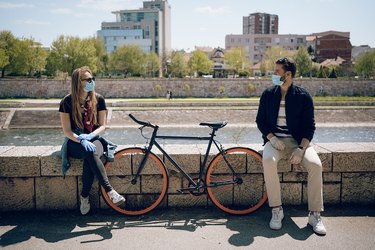
With the novel coronavirus continuing to spread across the world, you've probably heard health officials talk about herd immunity as one way to get the virus under control.
But what in the world is herd immunity, and how does it work? Here's what you need to know.
Video of the Day
Video of the Day
Get tips on how to stay healthy, safe and sane during the novel coronavirus pandemic.
The 411 on Herd Immunity
When you think of immunity, you probably think of something like chicken pox. Once you've had the itchy, red spots, you can't get them again. In other words, you're immune. And as a bonus, you can't pass on the disease to anyone else.
Of course, if everyone in a community is immune to an infectious disease, it can't spread. But it turns out that you can stop the spread of a disease without everyone being immune.
Herd immunity is when the majority of the people in a community are immune to a specific infectious disease.
"Like all forms of life, a virus wants to produce more virus. The only way it can do that is to go from someone who is infected to someone who is not infected and therefore not immune," John Swartzberg, MD, clinical professor emeritus of infectious disease at UC Berkeley School of Public Health, tells LIVESTRONG.com. "If you're immune and the virus jumps from me to you, the virus is not going to spread."
In a nutshell: If there is widespread immunity, the virus doesn't have anywhere to go and eventually dies out.
Related Reading
Why Is Herd Immunity Important?
Not only does herd immunity help stop the spread of infectious diseases, it creates a ring of protection around the people scattered within the community who are not immune. Think of herd immunity like a societal force field against the disease.
It's particularly important for people with weak immune systems who may develop an infection more easily or who can't be vaccinated, Dr. Swartzberg says. This includes older adults, people with conditions like diabetes or heart disease, pregnant women and babies and those who are otherwise immunocompromised.
"You have a strong herd to protect those who can't be immunized," he says.
How Do You Achieve Herd Immunity?
Dr. Swartzberg says there are two main ways to develop herd immunity:
1. Naturally: The community can develop natural immunity. When you get sick, your body develops antibodies to fight the infection. Your body keeps these antibodies so it's ready to fight the disease should you encounter it again.
2. Vaccines: Vaccines can also help develop immunity in people. A vaccine imitates the infection and tricks your body into producing antibodies.
When exactly herd immunity kicks in depends on how contagious the virus is, or its reproduction number (R0 or "R naught").
"It's the number of people one person, on average, will infect in a community where no one is immune," Dr. Swartzberg says.
So if the R0 is two, that means someone who is infected will spread the diseases to two people, on average, while they are contagious. The higher the R0, the more contagious the disease and the greater portion of the community needs to be immune in order to stop the spread.
When herd immunity is broken, a hot spot can develop in a community. For example, in recent years we've seen outbreaks of highly contagious diseases like measles, which has a R0 between 12 and 18.
"Measles requires a herd immunity of somewhere between 93 to 95 percent of the population," Dr. Swartzberg says. When immunity to measles in the community drops below that critical number, the disease can begin to spread like wildfire.
For diseases that have a vaccine, Dr. Swartzberg says the best thing you can do to ensure the health and safety of your community is to get vaccinated. And stay up-to-date with your immunizations, too. For some diseases, immunity can wane after a certain period of time so it's important to keep the force field intact. (That's why you need to get the flu shot every year.)
If a vaccine doesn't yet exist, like in the case of COVID-19, it's a little trickier. COVID-19 requires 60 to 70 percent of the population in the community to be immune in order to achieve herd immunity, Dr. Swarzberg says. However, relying on natural immunity may cost many lives.
That's where shelter-in-place and social distancing regulations come in. "We're trying to do what makes sense to save as many lives as we can until we get to herd immunity," Dr. Swartzberg says. "At the end of all this, the hope is that we'll have a safe and effective vaccine and we will have lost the minimal number of lives."
To sum it up: Herd immunity is the responsibility of both an individual and the community as a whole. "We have a responsibility to ourselves to protect ourselves. But we also have a responsibility to others in our community," Dr. Swarzberg says.
Concerned About COVID-19?
Read more stories to help you navigate the novel coronavirus pandemic:
Is this an emergency? If you are experiencing serious medical symptoms, please see the National Library of Medicine’s list of signs you need emergency medical attention or call 911.